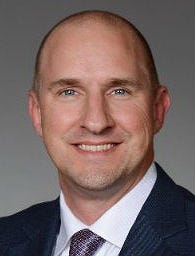Last summer, Windstream updated its UCaaS portfolio by adding Broadview Networks’ OfficeSuite paired with its SD-WAN.

The path to a stronger and more profitable Windstream relies heavily on increasing sales of SD-WAN and UCaaS.
That’s according to Bob Gunderman, Windstream’s chief financial officer. He spoke this week at the J.P. Morgan 2018 Global High Yield and Leveraged Finance Conference.
“As you look at what has occurred most recently in our business, roughly 30-40 percent of the sales that we are making every single quarter within our business today are coming from SD-WAN, UCaaS and on-net services,” he said. “And I think that will increase over time. We think we can get to a roughly 50 percent penetration of sales within 2018 and beyond, and we’ll just continue to push for those goals.”

Windstream’s Bob Gunderman
Last summer, Windstream updated its UCaaS portfolio by adding Broadview Networks’ OfficeSuite paired with its SD-WAN. Windstream acquired Broadview, a provider of cloud-based-UC to SMBs, for $228 million.
“A lot of the market will move to the SD-WAN-type services combined with UCaaS,” Gunderman said. “We think over time that’s certainly going to be an attractive market for us to take advantage of. And as you think about our market-share position today and how we think about the migration from legacy technology to these services, we embrace the transition. Because we are a provider that has provided services for years with leasing network from other carriers, when the transition occurs to SD-WAN and UCaaS from legacy services, that could be gross margin opportunity for us and in many cases It will be.”
With legacy services, it wouldn’t be uncommon for Windstream to be providing network connectivity over an Ethernet or legacy TDM connection at a third-party cost per location, he said. Switching to SD-WAN lowers that access cost, which “can be shared with our customer,” he said.
“Our gross margins on that particular transaction would actually go up, and then certainly when you overlay the opportunity to put into the mix a UCaaS product where we in fact own the IP for that technology of OfficeSuite, gross margins can go up considerably because we’re not paying anybody a third-party cost to provision that,” Gunderman said. “So not only do we think that will be a more desirable product set in the marketplace, but we think it’s a better financial answer for Windstream.”
When approaching customers using MPLS, Windstream would “begin with the pitch of, we will provision the network based upon the capacity needs and the flexibility that they want within their network, whether that’s a hybrid solution that includes some MPLS and SD-WAN at some of the branch locations … we would construct the solution based upon the customer needs,” he said.
“But we would begin with we would like to do as much of that as we can,” Gunderman said. “If, however, the customer said, ‘Look, we want to provision or …
… procure those access services from another carrier but we would like you, Windstream, to be the network aggregator, or provider of the managed services for the network of SD-WAN or even UCaaS,’ then we would do that as well.
“In that case I would consider ourselves to be an access-agnostic provider, meaning we would just as readily take a cable broadband connection or an Ethernet connection, or whatever the connection might be, to aggregate those services and construct the solution for the customer and manage it to whatever specifications the customer would want.”
While Windstream expects strong financial returns from SD-WAN, “it is accurate to say in telecommunications pricing yield goes down over time and consumption of bandwidth increases,” he said. However, by taking “ourselves and our customers through this transition, it will be improved,” he added.
Read more about:
AgentsAbout the Author(s)
You May Also Like


